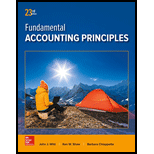
Asset:
An asset means a possession of property tangible or intangible which has some value; such that it can be realized in monetary terms and such asset can be liquidated in short-term or long-term approach so as to derive its value in cash.
Current Assets:
A current asset can be as the asset of any entity that is in the form of cash, cash equivalent or in a form which can be converted into cash within a year. Generally the current are defined to be the ones which can be liquidated within a year but if the company's operating cycle exceeds one year even though the assets are regarded as current assets until they get converted into cash ultimately as the last stage of operating cycle.
Long-term Assets:
Long-term assets are the assets possessed by the company which cannot be liquidated before one year. The minimum maturity period for the said assets is one year. These assets are being recorded in the books at the purchase price and are adjusted by the
To determine: The long-term assets given in the
Want to see the full answer?
Check out a sample textbook solution
Chapter 10 Solutions
Fundamental Accounting Principles
- What would be the effect on operating incomearrow_forwardBill Inc., wants to make a profit of $25,000. It has variable costs of $80 per unit and fixed costs of $15,000. How much must it charge per unit if 4,000 units are sold? a. $85 b. $105 c. $100 d. $90 MCQarrow_forwardCan you explain this financial accounting question using accurate calculation methods?arrow_forward
- Inventory: Omega Enterprises has an annual demand for units of inventory of 1,500 per year. The cost of placing an order each time is $75, and each item of inventory costs $3 to store. In this case, what would be the optimal amount of stock that should be ordered? Answerarrow_forwardQuestion: Skyline Enterprises has an average collection period of 25 days. Its average daily investment in receivables is $95,000. What is the receivables turnover?arrow_forwardPlease explain the solution to this financial accounting problem with accurate explanations.arrow_forward
- Sheinberg Industries reported 2023 sales ($ in millions) of $6,842 and a cost of goods sold of $5,120. The company uses the LIFO method for inventory valuation. It discloses that if the FIFO inventory valuation method had been used, inventories would have been $89.6 million and $73.2 million higher in 2023 and 2022, respectively. If Sheinberg used the FIFO method exclusively, it would have reported 2023 gross profit closest to? a. $1,110.5 million b. $1,319.1 million c. $1,738.4 millionarrow_forwardWhat would be the balance of the ending work in process inventory account?arrow_forwardI am searching for the correct answer to this financial accounting problem with proper accounting rules.arrow_forward

 AccountingAccountingISBN:9781337272094Author:WARREN, Carl S., Reeve, James M., Duchac, Jonathan E.Publisher:Cengage Learning,
AccountingAccountingISBN:9781337272094Author:WARREN, Carl S., Reeve, James M., Duchac, Jonathan E.Publisher:Cengage Learning, Accounting Information SystemsAccountingISBN:9781337619202Author:Hall, James A.Publisher:Cengage Learning,
Accounting Information SystemsAccountingISBN:9781337619202Author:Hall, James A.Publisher:Cengage Learning, Horngren's Cost Accounting: A Managerial Emphasis...AccountingISBN:9780134475585Author:Srikant M. Datar, Madhav V. RajanPublisher:PEARSON
Horngren's Cost Accounting: A Managerial Emphasis...AccountingISBN:9780134475585Author:Srikant M. Datar, Madhav V. RajanPublisher:PEARSON Intermediate AccountingAccountingISBN:9781259722660Author:J. David Spiceland, Mark W. Nelson, Wayne M ThomasPublisher:McGraw-Hill Education
Intermediate AccountingAccountingISBN:9781259722660Author:J. David Spiceland, Mark W. Nelson, Wayne M ThomasPublisher:McGraw-Hill Education Financial and Managerial AccountingAccountingISBN:9781259726705Author:John J Wild, Ken W. Shaw, Barbara Chiappetta Fundamental Accounting PrinciplesPublisher:McGraw-Hill Education
Financial and Managerial AccountingAccountingISBN:9781259726705Author:John J Wild, Ken W. Shaw, Barbara Chiappetta Fundamental Accounting PrinciplesPublisher:McGraw-Hill Education





